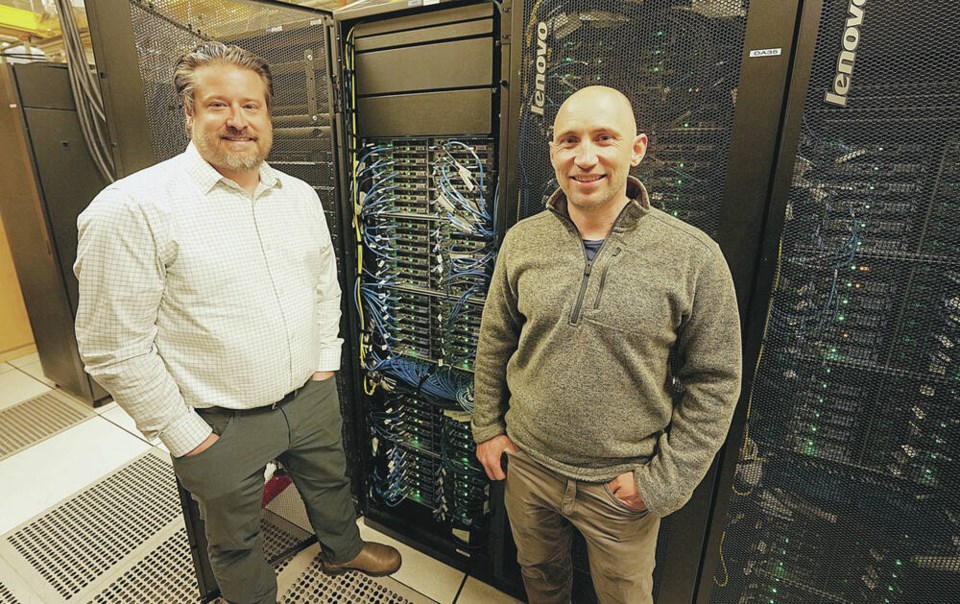In the windowless, nearly air-sealed building at the University of Victoria that houses the supercomputer network known as Arbutus, the roar of hundreds of fans makes conversation difficult.
There are rows upon rows of seven-foot-tall server racks with blinking lights in a room about the size of two basketball courts.
Perforated floor tiles cycle cooled air from a building-wide system that prevents the room from boiling over.
Jeff Albert, who manages a team of system administrators and specialists who work on computing infrastructure, said some areas of the room can still heat up to 40 C.
“Working back there is very unpleasant and you don’t want to do it for long,” he said. “Data centres are a very particular building. They’re made to keep computers happy, not people.”
But Albert’s team will be in the building often in the coming months for what he calls a “complete replacement” of Canada’s largest 24/7 remotely accessible supercomputer — a task he equates to “rebuilding a plane while it’s still flying.”
On Monday, Minister of Jobs, Economic Development and Innovation Brenda Bailey announced $6.1 million in funding from the B.C. Knowledge Development Fund for Arbutus as part of a larger investment in B.C. post-secondary computing infrastructure.
That’s in addition to a $10.3-million contribution from the Digital Research Alliance of Canada, a federally funded nonprofit, for a total of $16.4 million.
Established in 2015, Arbutus accounts for 80 per cent of Canadian research cloud computing capacity.
Albert said Arbutus has received steady upgrades over the years. “Each new phase is slightly denser and slightly more efficient.”
But the new funding will allow for every part of the supercomputer to be brought up to the latest standards.
The Arbutus network is accessed by more that three million users across the world, including more than 1,000 research teams across Canada.
The on-demand network hosts virtual machines and cloud computing workloads for a wide range of projects.
Arbutus services are available free of charge for Canadian post-secondary institution faculty members and their collaborators.
UVic professors have conducted research on topics such as scenario modelling for decarbonization and secure cloud-based real-time ECG heart monitors with the supercomputer’s help.
It’s also a hyper-secure environment — every photo published of the supercomputer has to be vetted by a manager to protect data security.
Randall Sobie, director of the Victoria Subatomic Physics and Accelerator Research Centre, whose research ranks among the supercomputer’s heaviest users, said the upgrade will likely double or triple its capacity.
Sobie, a particle physicist and professor at UVic, works with data generated by Vancouver’s TRIUMF accelerator centre and the Large Hadron Collider in Switzerland.
His research, which analyzes what happens when particles collide at very high energies, essentially allows scientists to look back into time, he said.
“This gives us a clue as to how the universe was formed and some of the big questions there.”
Analyzing petabytes — a petabyte is 1,000 terabytes — of data generated by the experiments takes a lot of computing power, he said. “If you can do it in a minute rather than waiting two days, that’s a big advantage.”
UVic computer science professor Sudhaker Ganti said supercomputers like Arbutus help researchers save time and money and are more efficient than a traditional computer.
“You don’t have to buy or upfront equipment … you can basically get a virtual machine with everything built in and just start running right up, immediately,” he said.
Recent developments in computing infrastructure are also allowing for water-cooled machines, said Ganti, adding that the heated water could be used for other purposes, such as heating buildings.
Albert said he can’t comment on what type of cooling system Arbutus will use in the future, as the university is still seeking suppliers.
The supercomputer currently runs at near maximum capacity, with about five to 15 per cent computing power left free for new projects on any given day.
“There’s a deep need for these resources to be available as quickly as we can provide them,” Albert said. “Our goal is to make sure that we offer it as quickly as possible.”
UVic has committed to completing all the upgrades by April 25, 2025, he said.
On Monday, Simon Fraser University was also given $80 million to upgrade its supercomputer from provincial and federal funding sources.
In a statement, Digital Research Alliance CEO George Ross said the upgrades at UVic and SFU represent a significant boost of Canada’s national computing infrastructure.
“Data is an essential national asset, foundational to our country’s knowledge creation, economic growth and social impact.”
>>> To comment on this article, write a letter to the editor: [email protected]



